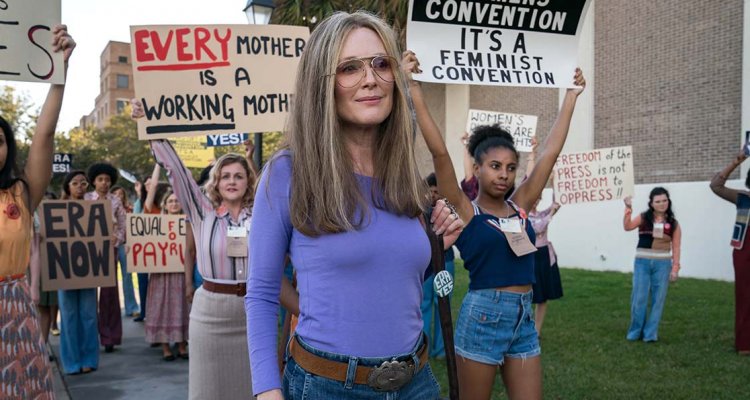Conventional biopics are inherently tricky to pull off. Condensing an extraordinary life into 2 hours or less often leads to compromise, a shallow greatest hits reading, or something akin to a rote Wikipedia recap. Negotiating those hurdles while telling an entertaining story and trying to capture what made the subject’s life so special to begin with is even tougher. Thankfully, Julie Taymor (“Across The Universe“) takes a more unconventional, though not always successful, approach in her latest film—somewhat akin to Todd Haynes’ approach to Bob Dylan in “I’m Not There,” but not as bold— about feminist icon, journalist Gloria Steinem in “The Glorias.” Despite an absence from the screen for a decade, Taymor’s latest manages to be both a loving tribute to American trailblazer and the power of collective action to bring social change. It’s also visually vivid and unexpected, but unfortunately, fairly uneven overall.
READ MORE: 52 Films Directed By Women To Watch In 2020
Mixing in fantasy elements with more grounded qualities, and scenes varying in styles and formats (black and white photography, rear projection that makes driving scenes look like a movie from the ‘50s, etc.), Taymor’s movie features four actresses playing Steinem in various stages of her life (which feels like a bargain in this economy) and dips around through the people and women who helped forge her voice.
READ MORE: The 25 Most Anticipated Movies Of The 2020 Sundance Film Festival
Julianne Moore begins the movie as Steinem taking a trip on a Greyhound bus, shot in crisp a black-and-white. She meets what seems to be an intimidating biker who turns out to be a big fan and the drama then starts to reflect, taking a trip down memory lane to Gloria’s childhood. The youngest Gloria (Ryan Kiera Armstrong) is introduced and so is her father (Timothy Hutton) who impresses upon her that the best education is traveling—an element that would become a big part of Gloria’s life later on in life, and the inspiration behind her memoir, My Life On The Road.
READ MORE: 100 Most Anticipated Films Of 2020
“The Glorias,” however, is an overly long movie and this section strains to justify its existence in retrospect when its run time feels baggy. While Gloria’s relationship to her traveling father—and also her mother Ruth (Enid Graham) who is a former journalist, also struggling with mental illness – set the foundation for the rest of Gloria’s life, none of it comes into play until Gloria’s teen years (Lulu Wilson playing the character) and therefore feels more and more unnecessary as the accumulation of narrative adds up.
READ MORE: The 25 Best Movies Of 2020 We’ve Already Seen
“The Glorias” really comes alive in the middle, during Steinem’s (Alicia Vikander) college graduate years, her fellowship program in India, and the start of her journalism career. Vikander gets arguably the meatiest of the segments, and she absolutely shines portraying Gloria at the beginning of her career as a confident but frustrated reporter fighting to cover the big issues that no male editor cares about. This version of Gloria also goes through some dark moments that the actress conveys with ease, such as Gloria’s abortion and her desire to change the world while enduring endless comments about her looks.
READ MORE: The 100 Best Films Of The Decade [2010s]
This segment covers her famous Playboy Bunny expose and the start of her career as an activist. It’s also here where Gloria’s relationship with her mother and her various meetings with inspirational and powerful women take place, slowly but surely building towards what Taymor describes as the film’s unofficial subtitle “Meetings With Remarkable Women.” Taymor also puts her dazzling visual style in the spotlight, with a remarkable transition that occurs when Vikander’s Steinem is interviewed on TV, and after a sexist comment, we see Julianne Moore (playing an adult Gloria) takes her place and shuts down the interviewer.
If Vikander plays Steinem as a woman trying to carve out her own space in the world, Moore turn as Gloria’s is that of an icon and a role model. We see the debut of Ms. Magazine, seminal public speaking and activist efforts, with a focus on the work to pass the Equal Rights Amendment. Vikander’s story is an emotional and compelling one about hardships and the difficulty of being taken seriously in a male-dominated world Moore’s is in full empowering and call-for-action-mode.
Taymor has no issues balancing these two elements, and it is riveting to see Steinem’s work as an activist, and the extraordinary amount of work she and all the women she met along the way did, ending on real footage from the Woman’s March just a couple of years ago, as the real Gloria Steinem takes the spotlight. Seeing how emotional and compelling the second and third acts of the movie are, it just confirms how much the first act could use serious trimming.
What differentiates “The Glorias” from similar biopics is the framing device Taymor employs to unite the different Steinems. Eventually, all the different Glorias show up on the bus shown in the beginning, each asking the others about their shared existence, their expectations and disappointments in life. It has all the potential to feel ham-fisted, but Taymor emphasizes the theme of Steinem, not just as an individual, but a combination of all her influential experiences. Sadly, some of the more daring and imaginative ideas backfire. One scene in particular, that transforms all the Glorias into witches, in a “Wizard of Oz”-inspired segment to visualize sexist despair feels very showy and ill-conceived.
“The Glorias” stumbles when it plays the notes of a conventional biopic. It is only when Julie Taymor starts diving into the extraordinary work of Gloria Steinem, and the women that made her who she is, that the film becomes blossoms into something special. [B]
Follow along for all of our coverage from the 2020 Sundance Film Festival here.

